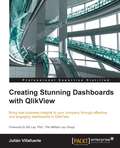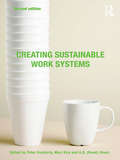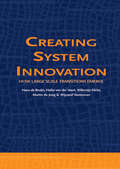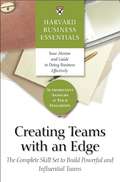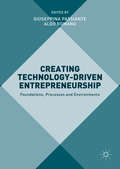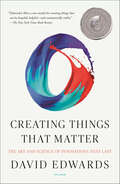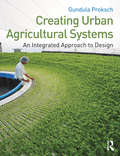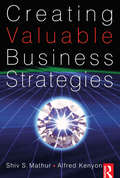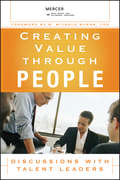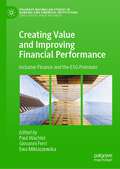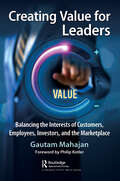- Table View
- List View
Creating Strategic Value: Applying Value Investing Principles to Corporate Management
by Joseph Calandro CalandroThe principles of value investing have resonated with savvy practitioners in the world of finance for a long time. In Creating Strategic Value, Joseph Calandro Jr. explores how the core ideas and methods of value investing can be profitably applied to corporate strategy and management.Calandro builds from an analysis of traditional value investing concepts to their strategic applications. He surveys value investing’s past, present, and future, drawing on influential texts, from Graham and Dodd’s time-tested works to more recent studies, to reveal potent managerial lessons. He explains the theoretical aspects of value investing-consistent approaches to corporate strategy and management and details how they can be successfully employed through practical case studies that demonstrate value realization in action. Calandro analyzes the applicability of key ideas such as the margin-of-safety principle to corporate strategy in a wide range of areas beyond stocks and bonds. He highlights the importance of an “information advantage”—knowing something that a firm’s competitors either do not know or choose to ignore—and explains how corporate managers can apply this key value investing differentiator. Offering expert insight into the use of time-tested value investing principles in new fields, Creating Strategic Value is an important book for corporate strategy and management practitioners at all levels as well as for students and researchers.
Creating Stunning Dashboards with QlikView
by Julian VillafuerteBring real business insights to your company through effective and engaging dashboards in QlikViewAbout This BookBuild outstanding dashboards that respond to your company's information needsPresent the data in efficient and innovative ways to promote insightsUnleash the true power of QlikView by creating engaging visualizationsWho This Book Is ForThis book is focused on QlikView developers with basic knowledge of scripting and layouts who want to improve their designing skills and build effective, eye-catching dashboards that deliver tangible value to their business.What You Will LearnBuild a comprehensive library of QlikView components to speed up your developmentsDefine a practical roadmap that will help you build business-driven dashboardsExplore the most effective and engaging ways to present dataApply the best practices in the field of data visualizationAvoid common pitfalls when creating bar, line and pie chartsCreate robust visualizations such as heat maps, histograms and scatter plotsIn DetailQlikView is one of the most powerful analytical tools in the market. Based on an in-memory associative model, it lets users freely navigate through the data, spot trends and make better decisions. This platform is capable of integrating a wide range of data sources like ERP systems, data warehouses or spreadsheets into a single application in order display dashboards with state-of-the-art visualizations.Creating Stunning Dashboards with QlikView is an easy to follow handbook that guides you through the process of creating an effective and engaging dashboard that delivers tangible value to the business. It starts with the identification of the business needs and the definition of the main KPIs, and takes you all the way to the application rollout.Throughout the book, you will learn how to apply some of the best practices in the field of data visualization, create a robust navigation schema, chose the best chart types for each scenario and many other things that will help you create effective dashboards that uncover all the stories behind the data.Style and approachThis easy-to-follow compilation of best practices, tips, and tricks will help you leverage your QlikView developments. Each section presents practical guidelines to help you create dashboards that are not only functional, but also engaging and compelling.
Creating Success from the Inside Out
by Ephren W. Taylor Emerson BrantleyCreating Success from the Inside Out shares the inspiring and motivational story of Ephren Taylor, one of the world's youngest-ever CEOs of a publicly traded company. A millionaire by the young age of sixteen, Taylor tells you what it takes to succeed in life by following your own path and refusing to be defeated. When you ignore the voices of negativity and follow our own true passions, there are no obstacles you can't overcome.
Creating Successful Business Models: Lessons from Social Entrepreneurship
by John Elkington Pamela HartiganSocial and environmental entrepreneurs are learning to channel their convictions, boundless creativity, and ability to amass the necessary resources into building sustainable systems and structures that address the most pressing market failures of our time. In this chapter, the authors examine the three categories of business models that leading social enterprises seem to fall into, discussing the challenges and opportunities of each for mainstream organizations.
Creating Sustainable Bioeconomies: The bioscience revolution in Europe and Africa (Routledge Studies in Ecological Economics)
by Ivar Virgin E. Jane MorrisThe growing global demand for food, feed and bio-based renewable material is changing the conditions for agricultural production worldwide. At the same time, revolutionary achievements in the field of biosciences are contributing to a transition whereby bio-based alternatives for energy and materials are becoming more competitive. Creating Sustainable Bioeconomies explores the prospects for biosciences and how its innovation has the potential to help countries in the North (Europe) and the South (Africa) to move towards resource efficient agriculture and sustainable bioeconomies. Throughout the book, the situations of Europe and Sub-Saharan Africa will be compared and contrasted, and opportunities for mutual learning and collaboration are explored. The chapters have been written by high profile authors and deal with a wide range of issues affecting the development of bioeconomies on both continents. This book compares and contrasts the situations of these two regions as they endeavour to develop knowledge based bioeconomies. This volume is suitable for those who are interested in ecological economics, development economics and environmental economics. It also provides action plans assisting policy-makers in both areas to support the transition to knowledge based and sustainable bioeconomies.
Creating Sustainable Careers in Student Affairs: What Ideal Worker Norms Get Wrong and How to Make It Right
by Margaret W. Sallee, Kristen A. RennThis book argues that the current structure of student affairs work is not sustainable, as it depends on the notion that employees are available to work non-stop without any outside responsibilities, that is, the Ideal Worker Norm. The field places inordinate burdens on staff to respond to the needs of students, often at the expense of their own families and well-being. Student affairs professionals can meet the needs of their students without being overworked. The problem, however, is that ideal worker norms pervade higher education and student affairs work, thus providing little incentive for institutions to change. The authors in this book use ideal worker norms in conjunction with other theories to interrogate the impact on student affairs staff across functional areas, institutional types, career stage, and identity groups. The book is divided into three sections; chapters in the first section of the book examine various facets of the structure of work in student affairs, including the impact of institutional type and different functional areas on employees’ work-lives. Chapters in the second section examine the personal toll that working in student affairs can take, including emotional labor’s impact on well-being. The final section of the book narrows the focus to explore how different identity groups, including mothers, fathers, and people of color, navigate work/life issues. Challenging ideal worker norms, all chapters offer implications for practice for both individuals and institutions.
Creating Sustainable Fiscal Space for Infrastructure: The Case of Tanzania
by Richard Hughes Teresa Ter-Minassian Alejandro HajdenbergA report from the International Monetary Fund.
Creating Sustainable Results with Solution-Focused Applied Psychology: A Practical Guide for Coaches and Change Facilitators
by Louis CauffmanThis practical, evidence-based guide details how professional practitioners and change facilitators can integrate a solution-focused approach into their daily work and practice. While conventional therapeutic methods centre on the assumption that problems arise due to deficiencies, and therefore focus on diagnosis and subsequent treatment, the solution-focused approach is resource-based and operates on the assumption that human beings always have resources at their disposal to move forward. Free from the burden of detailed problem analysis, the solution-focused approach prioritizes clients’ hope for change in their lives and taps into the opportunities and resources available to bring about such transformation. The solution-focused practitioner is able to design incisive interventions that are flexible enough to adapt to any situation clients might find themselves in, and this book provides a practical formulation that is immediately applicable to all professional fields of applied psychology. Creating Sustainable Results with Solution-Focused Applied Psychology is important reading for therapists and coaches of all schools of thought, as well as anyone who practices as a professional change facilitator, including social workers, mediators, business leaders, and educators.
Creating Sustainable Work Systems: Developing Social Sustainability
by Peter Docherty Mari Kira A. B. Rami ShaniSince the first edition of this book was published, the subject of sustainability has risen to the forefront of thinking in almost every subject within business and management. Tackling the latest developments and integrating practical perspectives with rigorous research, this new edition sheds light on a vital aspect of working life. Current trends reveal that increasing intensity at work has major consequences at individual, organizational and societal levels. Sustainability in work systems thus requires a multi-stakeholder approach, emphasising a value-based choice to promote the concurrent development of various resources in the work system. This sustainability grows from intertwined individual and collective learning processes taking place within and between organizations in collaboration. In exploring the development of sustainable work systems, this book analyzes these problems, and provides the basis for designing and implementing 'sustainable work systems' based on the idea of regeneration and the development of human and social resources. The authors, who are leading researchers and practitioners from around the world, consider the existing possibilities and emerging solutions and explore alternatives to intensive work systems.
Creating Synergies through Shared Services
by Robert S. Kaplan David P. NortonBeyond aligning the business units that sell products and services to external customers, organizations can create synergies by aligning their internal units that provide shared services, including purchasing, manufacturing, and distribution. The Balanced Scorecard has been used in numerous ways to help link shared service units with business units and with corporate strategy. This chapter presents two models for developing shared service scorecards: the Strategic Partner Model, and the Business-in-a-Business Model.
Creating System Innovation: How Large Scale Transitions Emerge
by M. de Jong H. de Bruijn H. van der Voort W. Dicke W. VeenemanSystem innovation' is a radical change of institutions, structures and values concerning one or more entire sectors.This publication from the Consultative Committee of Sectorcouncils for Research and Development in the Netherlands draws conclusions about the possible role of governments when 'system innovation' is predominantly emergent, questionin
Creating Teams With an Edge
by Harvard Business School PressTeams can be a driving force for organizational performance--and managers can play a key role in teams' ultimate success or failure. Highlighting the latest research on team development and dynamics--and including hands-on tools for improving communication, resolving conflicts, promoting interdependence, and more--this guide helps managers at all levels to motivate teams to achieve higher performance.
Creating Technology-Driven Entrepreneurship: Foundations, Processes and Environments
by Giuseppina Passiante Aldo RomanoThis book proposes a comprehensive analysis of the existing schools ofthought on technology-driven entrepreneurship to point out the process-based nature of this phenomenon. It explores whether entrepreneurship can belearned and examines the main processes that help influence entrepreneurialmind-sets. In the current economic landscape, technology-drivenentrepreneurship is the driving force behind national economies and entrepreneurialsocieties. It is the engine of innovation, job creation, productivity andeconomic growth, bringing benefits both at the level of the individual and ofthe society and promoting sustainable smart growth and development. Thisbook provides a comprehensive view of "how" entrepreneurs and futureentrepreneurs learn and develop their business ventures in a wider environment. Moreover, it discussesissues concerning setting up thesuitable entrepreneurial environments, processes, values and policies toencourage and foster individual entrepreneurial aptitudes. It also explores practices fordeveloping technology-driven entrepreneurship in a European context as well asin emerging regions.
Creating Things That Matter: The Art and Science of Innovations That Last
by David EdwardsMost things we create will not matter. This book is about creating things that do, from a master innovator who brings science and art together in his cutting edge labs.Art and science are famous opposites. Contemporary innovation mostly keeps them far apart. But in this book, David Edwards—world-renowned inventor; Harvard professor of the practice of idea translation; creator of breathable insulin, edible food packaging, and digital scents—reveals that the secret to creating very new things of lasting benefit, including innovations we will need to sustain human life on the planet, lies in perceiving art and science as one.Here Edwards shares how he discovered a way of creating that transcends disciplines and incorporates the principles of aesthetics. He introduces us to cutting-edge artists, musicians, architects, physicists, mathematicians, engineers, chefs, choreographers, and novelists (among others) and uncovers a three-step cycle they all share in creating things that durably matter. This creator cycle looks unlike what we associate with game-changing innovation today, and aligns the most expressive art and the most revolutionary science in a radical reimagining of how we live. David Edwards and the innovators he profiles belong to an emerging grassroots renaissance flourishing in special environments that we all can make in our schools, companies and homes.Creating Things That Matter is a book for anyone wondering what tomorrow might be, and at last half believing that what they do can make a difference.
Creating Universes with SAP BusinessObjects
by Taha M. MahmoudThis book is aimed at both new developers as well as experienced developers. If you are a new SAP BusinessObjects Universe developer who is looking for a step-by-step guide supported with real-life examples and illustrated diagrams, then this book is for you. If you are a seasoned BusinessObjects Universe developer who is looking for a fast way to map your old experience in Universe designer to the newer Information Design Tool, then this book is for you as well.
Creating Urban Agricultural Systems: An Integrated Approach to Design
by Gundula ProkschCreating Urban Agriculture Systems provides you with background, expertise, and inspiration for designing with urban agriculture. It shows you how to grow food in buildings and cities, operate growing systems, and integrate them with natural cycles and existing infrastructures. It teaches you the essential environmental inputs and operational strategies of urban farms, and inspires community and design tools for innovative operations and sustainable urban environments that produce fresh, local food. Over 70 projects and 16 in-depth case studies of productive, integrated systems, located in North America, Europe, and Asia ,are organized by their emphasis on nutrient, water, and energy management, farm operation, community integration and design approaches so that you can see innovative strategies in action. Interviews with leading architecture firms, including WORKac, Kiss + Cathcart, Weber Thompson, CJ Lim/Studio 8, and SOA Architectes, highlight the challenges and rewards you face when creating urban agriculture systems. Catalogs of growing and building systems, a glossary, bibliography, and abstracts will help you find information fast.
Creating Valuable Business Strategies
by Shiv Mathur Alfred KenyonCreating Valuable Business Strategies will change existing mindsets about strategy. Here is an answer for the strategist who asks, 'What should I do differently next Monday morning?'.The object of strategy is to create financial value and the offering-centred approach of Creating Valuable Business Strategies provides a novel and pragmatic framework for setting strategic direction: choosing which markets to contest and how.This book:* Identifies the individual offering as the fundamental unit of strategy--the choices that customers make regarding individual offerings are at the root of a company's financial success.* Provides an innovative and comprehensive approach to profitable business strategy--designing each offering and also the collection as a whole.* Explains that strategy is a task for all businesses with offerings, even the smallest, not just the giants.The book first sets the scene and makes the case that each value-adding offering needs a competitive strategy: it must have a winning competitive position and use one or more winning resources. It provides the reader with a rich classification of how an offering can be competitively positioned vis-à-vis rival offerings and customers. Winning resources and why offerings need them is discussed next. Corporate strategy, i.e. the managing of the company’s whole collection of offerings is then examined. This is followed by a discussion of the implications for organizing and structuring for an offering-centred approach to strategy. Finally all the aspects of this new framework that may meet with resistance are explored.Creating Valuable Business Strategies is essential reading for anyone who is involved in designing tomorrow's offerings: from the backroom specialist to the CEO. It has a clear logical presentation with a focus on practical implementation.
Creating Value
by Rohit DeshpandeCreating value involves understanding consumers/customers and bringing this knowledge into the organization. Market-driven and market-driving strategies are contrasted in the context of new product development.
Creating Value Through People
by M. Michele Burns Llc MercerPractical guidance on how to empower people to do their best.Filled with stories by and fascinating interviews with human capital innovators, Making a Difference Through People provides practical guidance on how to empower people to deliver their best performance by employing their guiding principles. Offering relevant strategies and tactics, each interview is preceded by an introduction that provides a biographical recap and a brief discussion of each innovator.Mercer is the global leader for trusted HR and related financial advice, products and services. They work with clients at enhancing the financial and retirement security, health, productivity and employment relationships of the global workforce. M. Michele Burns is Chairman and Chief Executive Officer of Mercer Prior to being named Chairman and CEO of Mercer, Ms. Burns held the position of Chief Financial Officer for MMC.
Creating Value Through Sustainability: An Interdisciplinary Perspective (SIDREA Series in Accounting and Business Administration)
by Francesca BerniniAdopting a multidisciplinary approach, this book examines the interaction between ESG strategies and value creation. It highlights how sustainability is a wide-ranging concept capable of engaging the social sciences in various ways. Firstly, the study analyses how ESG initiatives can enhance value creation using a framework inspired by strategic cost management. Then, it takes an ethical perspective by investigating the ethics-washing phenomenon associated with the (ir)responsible use of artificial intelligence. Furthermore, the focus is on the integration of ESG factors into risk management and performance measurement systems through the lens of management accounting, and on the interplay between corporate social responsibility and tax avoidance. Moreover, the book proposes a constitutionally oriented reading of corporate sustainability from a legal standpoint. It also includes the perspective of financial companies, exploring the role of administrative controls in fostering banks' commitment to sustainability. The study focuses also on an organizational perspective by exploring how human resource management can support ESG strategies. Finally, the research underlines the corporate model “Società Benefit” to examine its effect on default risk.
Creating Value and Improving Financial Performance: Inclusive Finance and the ESG Premium (Palgrave Macmillan Studies in Banking and Financial Institutions)
by Paul Wachtel Ewa Miklaszewska Giovanni FerriThis book discusses the transformation of the banking industry, particularly after a number of recent shocks: 2008 financial crisis, 2012 Euro-sovereign crisis, the pandemic COVID-19 crisis, the technological revolution, and reputational problems in banking due to climate risk and ESG (Environmental, Social and Governance) metrics.The book emphasizes two post-pandemic issues: the role of financial education and inclusive finance, and responsible banking and ESG priorities. Individual chapters analyse how the pandemic shed new light on social and governance responsibilities: Major issues include the importance and efficiency of financial education, and the impact of ESG programs on firms’ value, banks’ probability of default, bank business models and reputation risk. The book also addresses investors’ behaviour and the factors which may bias financial disclosure and reporting. By addressing whether the post-2008 crisis bank restructuring has effectively created a resilient and sustainable banking system – mostly from the European market’s perspective – the book will be of interest to researchers, academics, policy makers, and professionals of banking and financial institutions.
Creating Value for Leaders: Balancing the Interests of Customers, Employees, Investors, and the Marketplace
by Gautam MahajanCreating value is the foundation of all business. It’s what sets you apart from your competition, secures long-term customers, and brings distinct meaning to your brand and your stakeholders. Without creating value for your business, your unique offering will be seen as just another commodity in the eyes of your target market. Creating value is in every business leader’s vocabulary and uppermost in their overall strategy. In fact, creating value is the purpose of a company according to the Business Roundtable and the World Economic Forum. That is another key reason why more people want to understand and utilise value creation for their benefit and the good of their stakeholders. Many companies and leaders seek to create value but do not know how to. As a result, they create and destroy value unconsciously. This book shows you how to create value consciously. To create long-term value, organizations need to put in place the mindset, capabilities, and relationships that enable them to meet the needs of their customers and stakeholders. This book makes value creation understood and used by executives and leaders more effectively. The book describes value creation in its various nuances, how it arises, how it is used, and the width and scope of value creation, from how it impacts a company and how that company can become more successful by creating value for customers and other stakeholders. The author also provides tips for CEOs, managers, HR, and other professionals on how to succeed in value creation as a long-term strategy and in day-to-day work. Numerous examples and case studies illustrate the points being made by the author.
Creating Value in Nonprofit-Business Collaborations: New Thinking and Practice
by James E. Austin M. May SeitanidiCollaboration between nonprofits and businesses is a necessary component of strategy and operations. Creating Value in Nonprofit-Business Collaborations: New Thinking & Practice provides breakthrough thinking about how to conceptualize and realize collaborative value. With over a hundred case examples from around the globe and hundreds of literature references, the book reveals how collaboration between businesses and nonprofit organizations can most effectively co-create significant economic, social, and environmental value for society, organizations, and individuals. This essential resource features the ground-breaking Collaborative Value Creation framework that can be used for analyzing the sources, forms, and processes of value creation in partnerships between businesses and nonprofits. The book is a step-by-step guide for business managers and non-profit practitioners for achieving successful cross-sector partnerships. It examines the key dimensions of the Collaborative Mindset that shape each partner's collaborative efforts. It analyzes the drivers of partnership evolution along the Collaboration Continuum, and sets forth the key pathways in the Collaboration Process Value Chain. The book concludes by offering Twelve Smart Practices of Collaborative Value Creation for the design and management of cross sector partnerships. The book will empower organizations to strategically increase the potential for value creation both for the partners and society. Praise for Creating Value in Nonprofit-Business Collaborations: New Thinking & Practice! "This is a playbook for enabling business and nonprofits to co-create shared value. These new types of collaborations about creating value, rather than the tense standoffs of the past, are part of the way we will create actual solutions to society's challenges." Michael J. Porter, Bishop William Lawrence University Professor, Harvard Business School "Co-creating value is a powerful concept Jim Austin and May Seitanidi are sharing with us that will bring business and non-profit leaders to a new level of understanding and performance. This new book is the indispensable guidebook for leaders of the future." Frances Hesselbein, Founding President and CEO of the Frances Hesselbein Leadership Institute, Former CEO of the Girl Scouts of America, and Holder of Presidential Medal of Freedom "I love the book! While it focuses on "cross sector" collaboration, it should be read by every executive in the "for-profit" sector. Business is about how to collaborate with stakeholders to create value. This book tells you how to do it. Bravo!" R. Edward Freeman, University Professor and Olsson Professor The Darden School University of Virginia "Finally a book that demystifies what is probably the single most indispensable strategy for advancing social change: cross sector collaboration that creates genuine, measurable value for all. The book is an original and valuable resource for both the nonprofit and business sectors, providing a promising new roadmap that shows how to go beyond fighting for one's share of the pie, to collaboration that actually makes the pie grow." Billy Shore, Founder and CEO of Share Our Strength and Chairman of Community Wealth Ventures "Professors Austin and Seitanidi provide essential guidance for managers determining how to produce benefits for their organizations and high impact for society. This is an informed, thoughtful, and practical analysis." Rosabeth Moss Kanter, Ernest L. Arbuckle Professor of Business Administration, Harvard Business School and author of SuperCorp: How Vanguard Companies Create Innovation, Profits, Growth and Social Good
Creating Value with Big Data Analytics: Making Smarter Marketing Decisions
by Peter C. Verhoef Edwin Kooge Natasha WalkOur newly digital world is generating an almost unimaginable amount of data about all of us. Such a vast amount of data is useless without plans and strategies that are designed to cope with its size and complexity, and which enable organisations to leverage the information to create value. This book is a refreshingly practical, yet theoretically sound roadmap to leveraging big data and analytics. Creating Value with Big Data Analytics provides a nuanced view of big data development, arguing that big data in itself is not a revolution but an evolution of the increasing availability of data that has been observed in recent times. Building on the authors’ extensive academic and practical knowledge, this book aims to provide managers and analysts with strategic directions and practical analytical solutions on how to create value from existing and new big data. By tying data and analytics to specific goals and processes for implementation, this is a much-needed book that will be essential reading for students and specialists of data analytics, marketing research, and customer relationship management.
Creating Value with Data Analytics in Marketing: Mastering Data Science (Mastering Business Analytics)
by Peter C. Verhoef Jaap E. Wieringa Edwin Kooge Natasha WalkThis book is a refreshingly practical yet theoretically sound roadmap to leveraging data analytics and data science. The vast amount of data generated about us and our world is useless without plans and strategies that are designed to cope with its size and complexity, and which enable organizations to leverage the information to create value in marketing. Creating Value with Data Analytics in Marketing provides a nuanced view of big data developments and data science, arguing that big data is not a revolution but an evolution of the increasing availability of data that has been observed in recent times. Building on the authors’ extensive academic and practical knowledge, this book aims to provide managers and analysts with strategic directions and practical analytical solutions on how to create value from existing and new big data. The second edition of this bestselling text has been fully updated in line with developments in the field and includes a selection of new, international cases and examples, exercises, techniques and methodologies. Tying data and analytics to specific goals and processes for implementation makes this essential reading for advanced undergraduate and postgraduate students and specialists of data analytics, marketing research, marketing management and customer relationship management. Online resources include chapter-by-chapter lecture slides and data sets and corresponding R code for selected chapters.

